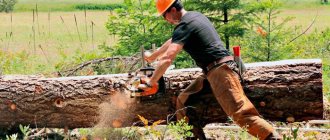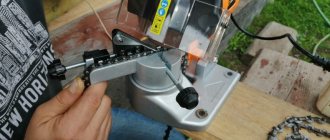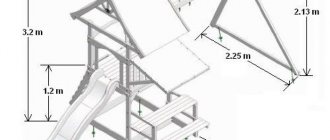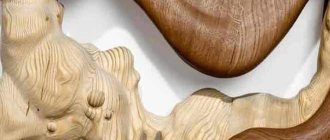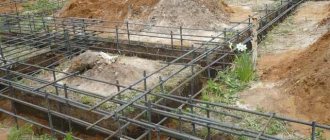It’s the 21st century, and the world has stopped being surprised by technological innovations. The stores display beautiful and convenient devices for sawing firewood from Sweden, Canada, and the USA, adapted for sawing with an electric or chainsaw. It’s even just nice to see how beautifully they are made: they clamp the log securely, and it’s very convenient to do sawing, and they’re compact, too. However, in life, our people have used various versions of their grandfather’s goats, and continue to use them. Anachronism and stinginess? Partly yes, but the main thing is that “classic” sawhorses are very comfortable and practical. Our ancestors were wise and experienced. Even the emphasis in the word that denotes this device was placed so that in the future there would be no misunderstandings and people would not confuse the term from household use with the name of innocent animals.
Anyone can quickly assemble this structure; the materials for making a sawhorse for cutting firewood are almost always at hand. However, for all the apparent simplicity, you should first draw a drawing or sketch. And it will be easier to work, and you won’t have to correct errors. It is imperative to take into account the height of the person who will cut the wood, and the type of saw with which the wood will be cut - a two-handed or chainsaw.
How to make your own sawhorses for cutting wood with a chainsaw
Cutting wood is more convenient and much easier with a chainsaw. Especially if the logs were brought to you thick and damp. Cut the firewood quickly, the performance with a chainsaw is completely different.
To cut firewood with a chainsaw, you can use sawhorses assembled according to the traditional pattern. But there is one serious inconvenience - the chain saw will definitely jam when you finish the cut. This happens when a cut is made between the posts (the end of the log protruding beyond the edge of the structure can be easily cut by the saw). To prevent pinching, the log must be turned with the saw down. This is additional and quite hard work, especially when you have to move hefty logs alone.
Craftsmen have developed (and perhaps some of them copied “in Chinese”) designs to avoid clamping the saw chain. And they even patented their designs. Such sawhorses for sawing firewood with a chainsaw can be divided into two types. The first includes metal structures in which the short end of the log is clamped with a chain or toothed grip, and the long free end protrudes far beyond the sawhorse. In these trestles, the supporting “heel” is made so that the log cannot disturb their equilibrium position. This design is reminiscent of imported factory-made goats. Ours just look simpler and the documentation for them (protected by a patent!) is orders of magnitude cheaper.
Another patent-protected design for sawing firewood with a chainsaw is a wooden one:
The advantages of this design include:
- The ability to cut logs alone, because there is no need to move them while working.
- There is no danger of the chain becoming pinched.
- Possibility to adjust the length of the blocks into which the log is cut. When working on such sawhorses, the blocks are the same length.
- Sawed off blocks, due to the design features of the sawhorse, roll in the direction opposite to the sawyer.
- Compact when folded. In the utility room near the wall they will take up very little space - the thickness in the folded position is only 12 cm.
Rules for safe cutting
Before cutting down a tree, think not only about your safety, but also whether surrounding objects and structures will be damaged by the saw. Look around: is there a highway, a railroad, a lawnmower, a building nearby? If this is the case, think twice before starting the job, perhaps in this case you should consult with specialists if you doubt your skills.
If the area is crowded, use warning signs. You wouldn't want to hurt someone by being careless, would you?
Before you start cutting, make sure you have enough fuel and oil.
- Determine the roll direction. Study the cut object, the area: whether the tree is growing evenly or not, whether there is a slope of the soil where the wind blows. It will be easier to calculate the direction in which the tree will fall. Based on this data, you can make further work easier. Numerous online chainsaw videos posted on the Internet will help you in this section.
- Turn right: clear the ground around the tree of bushes, undergrowth and undergrowth, and foreign objects. Nothing should interfere with your safe exit while cutting. You need to clear an area at a 45 degree angle to the back and sides of the direction of the wood.
READ How to Sawing a 38mm Tabletop
There are many obstacles that can make your dreams of the perfect chainsaw go no. Sometimes things can go wrong, but with AL-KO trees, going "wrong" can cost you or someone else's life. So remember your enemies personally
- Rot. A rotten tree may behave unpredictably and fall not exactly where you expect. To fight such an opponent, it is better to leave a professional. But once you pick it up yourself, remember: the tree looks unnatural, the trunk looks damaged, the bark is soft to the touch or discolored in places, most likely these are signs of rotting. In this case, you need to increase the file size to improve security.
- Stuck and the trees are stuck. If a tree gets stuck catching another trunk while cutting, you need professional help. Don't try to fix the situation yourself, call a specialist, but you can't leave the tree unattended.
- I'll try the file. If a tire gets stuck in the trunk, do not tear it, especially while driving. Stop the engine, hold your breath, and tilt the trunk until the chainsaw slides out.
- Swipe. In the hands of a non-professional, a rebound can occur in almost any situation. Typically the saw moves back and forth when the moving chain in the sprocket area of the driven bar comes into contact with another surface. In this situation the chain brake should work, if it does not, do it manually. Move the handle forward, you're done, you're safe.
How to make a sawhorse with your own hands for sawing firewood with a two-handed saw
Anyone who has ever sawed a large number of logs with a two-handed “friendship” saw (that’s right, with a small letter. This is not a brand of saw, but a hint of the friendship of two sawmills), knows well how important it is to correctly select the height of the log on the sawhorse. It is believed that the most comfortable height is from 90 to 110 cm. You don’t need to bend your back too much when bending forward, you don’t have to squat, you work comfortably and quickly. After all, working for a long time in an uncomfortable position the next morning will make you like a rusty iron woodcutter - your back and knees will bend with great difficulty.
In order to make sawhorses for sawing wood, we will need:
- Beam 100x100 mm, length 1100 mm. It will serve as the basis of the structure. You can also use a flat, dry and not very thick log as a base.
- Beam 50x50 mm, four sections of 1100 mm each. They will become the “legs” of the goat.
- Beam 50x50 mm, two pieces of 350 mm each. We will make “horns” from them.
- Beam 50x50 mm, two pieces of 1100 mm each for tying the “legs”.
- Self-tapping screws 5x100 mm, about 30 pcs. in total.
- Impregnation "Bioprotection".
We make cuts on the timber that will serve as the base. We make 12 cuts, two for each groove. We will need 6 grooves, each 25 mm deep, for the “legs” and “horns”.
Using a chisel and hammer, select the grooves along the intended cuts. We forcefully drive the prepared pieces of timber into the grooves: four “legs” and two “horns”. We tighten the screws. Using a hacksaw, we saw off the ends of the timber, which serves as “legs,” at an angle, so that the goats stand firmly and evenly on the ground. The trestle base is assembled.
Cutting logs with a chainsaw into boards with a device
When you need to cut a log lengthwise with a low-power chainsaw, you cannot do without special equipment and skills. This is how the YouTube channel Do-It-Yourself Joinery describes it.
Logs for cutting
The basis of a homemade cutting device is a carriage, which is welded from a 25 mm profile pipe. Two guide pipes with a cross section of 30 mm are welded to the carriage. To fix the carriage in height, two M8 bolts are installed on each pipe.
Carriage with guides
The moving part of the device is T-shaped. It is also made from 25 mm profile pipe. Each rack has clamps that secure the chainsaw bar.
Stands with clamps
To ensure that the chainsaw chain moves freely, metal jaws 4 mm thick and 40 mm in size are welded inside the clamps.
Jaws in a clamp
When cutting, the carriage should move easily along the guides, so rollers are attached from below in all corners. We need inexpensive furniture casters made of plastic.
Carriage with rollers
Before installation on the guides, the device is assembled.
Assembled device
One section of an aluminum ladder is used as a guide for the carriage. The carriage is installed on top of the stairs, and thanks to the rollers it easily moves along the guides.
Carriage on the stairs
The device is designed to work with a Husqvarna 555 chainsaw with a power of 3.1 kW.
Saw Husqvarna 555
For longitudinal cutting, a special chain is selected. It differs in the pitch of the links and the sharpening angle of the cutting edge. The chainsaw sprocket is selected to match the pitch of the links.
Comparison of rip saw chain
The depth of the log cut depends on the size of the tire. Husqvarna does not produce tires with an optimal length of 55 cm, so they purchase a Partner tire and select a chain with 68 links for it.
Saw guide Partner
To operate, the device is mounted on a chainsaw. First of all, put the racks on the tire and secure them. Then the carriage is put on the racks.
Saw with attachment installed
The ladder is secured to the log using brackets and planks.
Ladder fastening
After installing the chainsaw with the device on the stairs, select the size of the cut and use this size to set the height of the carriage on the guides.
Setting the cutting size
The cutting occurs by moving a carriage with a chainsaw along the guides along the log.
Log sawing
Video about how to cut a log into boards with a chainsaw with a device:
Preparing for work
The first thing to start working with a chainsaw is its assembly. The assembly diagram of different models is practically the same. The saw bar and chain are installed on the saw, and the chain is tensioned.
The chain can be considered correctly tensioned if it does not sag on the bar and can be easily turned by hand. If you have to apply too much force to turn the chain, it means it is too tight and you should loosen its tension a little.
Next, you need to check the sharpening of the chain; for this, the cutting edge of each working tooth is visually inspected. The edges must be smooth without dents or nicks.
The next step is refueling the chainsaw. The fuel mixture is prepared in a certain proportion, which can be found by reading the user manual supplied with the saw. Basically, the fuel mixture is diluted in a ratio of 1:50, that is, for one liter of AI-92 gasoline, you need to add 20 grams of oil for two-stroke engines.
Important: when pouring fuel and oil for chain lubrication into the tanks, you need to be extremely careful and not mix them up. If you pour oil into the fuel mixture tank, the chainsaw will not work. To restore functionality, you will need to flush the fuel tank with gasoline, as well as clean the fuel line and carburetor, which is quite difficult.
Consequences of improper sharpening
Often when working, the question arises why the chainsaw cuts crookedly. This is due to improper sharpening of the chain. When servicing cutting tools, it is very important to follow the work technology. If the chain is sharpened incorrectly, you will not be able to cut straightly with a chainsaw, because the arrow will go to the side. The situation can be corrected by repeating the maintenance on a special sharpening machine, using a file with a guide bar, or replacing the cutting tool with a new one.
Tree felling tools
In order to fell a tree in a certain direction, professional fellers and others use special tools. The most common of them are felling forks, wedges and blades. Special hydraulic or mechanical jacks can also be used.
Wedges can be made from wood directly at the felling site or purchased in specialized stores. Wedges made of polymer materials are widely used, the size of which is selected depending on the diameter of the tree being cut.
In order to have an idea about felling jacks, we recommend watching a video that shows how, using this device, a lumberjack cuts down and lays a pine tree in the direction he needs.
Felling blades work on the principle of a wedge, only they have a lever, thanks to which the operator can increase the force and help the tree fall in the desired direction. The principle of operation of the felling blade or also called the lever can be found out by watching the video below.
How to properly cut a log
The next stage after felling the tree is sawing it. It must be carried out following certain rules and according to a scheme.
Longitudinal sawing into boards
As you might guess, boards are made by cutting logs longitudinally. Since rip cutting will be required, the saw chain must be of the appropriate type. To ensure accurate cutting of the trunk into boards, a special Big Mill log sawing device is used, shown in the following figure.
With its help, it is possible to saw logs with a diameter of up to 500 mm. The thickness of the resulting board is set using a special ruler marked on the racks of the device. You can purchase it ready-made or make it yourself by watching this video.
To cut a log into boards of equal thickness, do the following.
- Take 2 straight boards and join them at a 90 degree angle to create a T-shaped structure, as shown in the following photo. It will serve as a ruler and allow the chainsaw to move smoothly. The boards are twisted taking into account the dimensions of the longitudinal cutting device so that the saw does not touch the ruler and passes 10 mm above it.
- Make 2 L-shaped pieces that will serve as stops to prevent the log from rotating. The boards can be connected with metal corners.
- Roll the log onto previously prepared stands (you can use small diameter logs). Of course, if the diameter of the log is large, then it will not be possible to do this alone.
- Screw the L-shaped stops to both ends of the log using long self-tapping screws. It is not recommended to use nails, since after the first longitudinal cut you will have to reconfigure the entire structure.
- The T-shaped ruler is attached to the stops using clamps.
- A chainsaw with a previously attached device is installed on the ruler.
- On the device, set the thickness of the board that you want to get as a result. In this case, it is necessary to take into account the thickness of the saw and a gap of 10 mm between the blade and the ruler.
- Rotate the log 30° away from you. At an angle, the sawing process will be more convenient.
- The next step is to cut the log lengthwise.
- Disconnect the ruler by unscrewing the clamps and unscrew the stops from the ends of the log.
- Place a T-shaped ruler on the resulting plane after cutting. Secure the guide using self-tapping screws.
- After securing the log so that it does not roll, make a second longitudinal cut. It will be perpendicular to the first resulting plane. If you make the third and fourth cuts in this way, each time turning the log and setting the ruler, you can saw off a square beam (beam) evenly.
- If it is necessary to cut a log into boards, then after the second longitudinal cut the ruler is removed and only the device is used. In this case, one of the planes will serve as a guide, and at the end you will get a semi-edged board.
Cross cutting of logs
To cut logs across the grain, it is necessary to install a cross-cut saw chain on the unit. Basically, the cross cut is used for sawing firewood. The resulting small cylinders are then split into firewood. To make it convenient to cut firewood, the logs are placed on trestles 600-800 mm high.
The timber is trimmed in the same way.
Log sawing scheme
Below is a diagram that shows how to properly dissolve a log into boards and beams.
This operation can be performed in several ways.
- Sawing a square beam occurs from the core part of the log.
- To get 2 rectangular beams, the square beam is sawn into 2 parts.
- By sawing a log crosswise, you can get 4 beams.
- This type of sawing is called “tumble” and is used on sawmill frames. All boards are unedged.
- With this type of log cutting, you can get a double-edged beam, as well as several unedged boards and a couple of slabs.
- Radial sawing is complex in its execution. A characteristic feature of boards when sawing in this way is vertical growth rings.
- The double-edged timber is dissolved into edged boards and 2 wanes.
- For boards with a horizontal arrangement of growth rings, the front side is called the one that is turned to the center of the log (core), and the back is called the side turned to the sapwood (this is the name of the periphery of the trunk).
Feller position
In order to avoid injury when cutting down a tree, the feller must always choose the correct position. The correct position is considered to be one in which the feller can escape from danger at any time. For this reason, before felling trees, the operator should clear away any small growth that could cause a tripping hazard. When felling, you need to hold the saw with both hands and be in the area opposite to where you plan to fell the tree.
It is allowed to be in the area of a falling tree only to cut out a wedge, which is done first.
Next, let's look at a couple of useful aspects of the work.
Processing frozen wood
Frozen trees, no matter what the species, are much more difficult to saw than dry trees, and therefore this type of sawing is a separate category. Due to the fact that trees are often cut in the cold season, selecting the optimal method for processing raw materials will be a very pressing problem. This will require tools with a strong construction - frozen wood will become stronger due to the fact that the moisture inside is frozen.
Sawing soft wood
If we talk about sawing soft wood, then things are somewhat different. Most of the methods that are used for sawing hardwood will work for softwood too. But there are other differences. Naturally, safety considerations must take precedence over the desire to produce as much product as possible in a limited time period.
It is natural to position the log in such a way that during sawing small defects appear inside the lumber, if everything is not so serious as to affect the final strength of the finished product. If possible, you should cut in such a way that all defects and knots are located on one side of the lumber, while at the same time the other side is clean.
True, in this case with building materials, a clean surface will not affect the final cost of the product, but large branches or even defects can greatly affect the structural strength. Select the worst side of the log and start sawing from there, making short lengths of lumber. The first lumber will be the worst, so it must be short to sell.
After the log has been sawn from the bad edge and along the entire length of the log, it is worth moving to the opposite edge, and also continue sawing parallel to the bark. From a good point, the width of the board you will cut should be no less than 0.15 m. On smaller logs, less than 0.3 meters in diameter, and the first board should be 0.1 meter wide. Larger logs will have far fewer defects inside, which means there will be no need to transfer them to larger structures for construction.
It is also worth always turning the log over to another side if the lumber from the new side turns out to be of better quality than from the one that was sawn before. This is how they make logs from waste - they cut the “ears” in one movement of the saw, and then turn the log over onto its “belly” and there is a chance that it will be possible to make at least a few small boards.
Safety precautions and personal protective equipment
A chain saw is a source of increased danger; working with it requires compliance with certain rules.
- The operator must be in normal condition when working with the tool. It is prohibited to use a chainsaw while under the influence of alcohol or drugs.
- It is forbidden to touch the saw attachment with your hands while the engine of the chainsaw is running.
- To prevent sawdust from getting into the eyes, the operator should wear safety glasses or use a face shield when using the saw.
- The chainsaw operates loudly, so it is necessary to take care of hearing protection. Use headphones or special earplugs.
- During the process of felling a tree, there is a risk of dry branches falling on the operator, so the work must be done in a helmet or hard hat.
- Shoes should be durable and non-slip; it is best to use special boots with protective plates in the toes to prevent injury if the chain breaks and hits the foot.
- Clothes should fit tightly to the body; this will reduce the risk of them getting caught and wrapped around the chain. The material from which the clothing is made must be dense and durable.
- It is not recommended to operate a chainsaw alone.
- You cannot refuel indoors or directly at the work site; after refueling, you must check the tightness of the tank filler cap.
- It is forbidden to refuel the saw while the engine is running.
- Transporting the assembled saw is only permitted with the protective tire cover on.
How to cut a log into boards with a chainsaw at home
The fallen trunk can be cut into logs on the ground if you plan to use the wood for kindling and firewood. There is no need to explain how to cut a log crosswise with a chainsaw, the technology here is simple, the main thing is to secure the log well so that it does not sway or move during cutting.
But if the trunk is good, you can cut the log into boards with a chainsaw at home and get absolutely free building materials needed in your own household.
In order to cut a log lengthwise with a chainsaw, you need several devices:
- The bed or frame where the log will be secured. To make it, a corner, channel or pipe is used that is thick enough to support the weight of the log.
- Chainsaw with attachment. You can use a gas cutter, debarker, vertical or horizontal attachment. The most accurate and efficient disintegration of the log is ensured by the horizontal attachment, but it can only be used if the length of the saw bar is no less than the thickness of the log. If you don’t have all this, you can do without an attachment - just make two simple devices with which cutting logs into boards with a chainsaw will be easy and simple.
- Sawing logs into boards with a chainsaw can be done independently without prior sanding - it’s easier to do this later.
Let's look at the easiest way to cut a log into boards with a chainsaw, that is, without specialized attachments. It is necessary to make two simple clamps, welded (the best option) or assembled using bolted connections.
These clamps are T-shaped and approximately 500-600mm long. Another plate or corner is attached to the short “stick” using bolts, and between them there should be a distance slightly greater than the thickness of the chainsaw bar.
The clamps are attached to a homemade carriage with a handle - when cutting logs into boards with a chainsaw, the carriage will move with its help.
Holes are made on the clamps - this will allow you to adjust the height when cutting the log lengthwise with a chainsaw.
https://youtube.com/watch?v=Grj15rGGYRQ
After the first cut of the log with a chainsaw has taken place, it is raised to the required height and the next cut is made according to the same pattern.
How to cut down a tree with a chainsaw
Now let's figure out how to cut down a tree with a chainsaw. The first thing you need to start with is cleaning the small growth around the trunk. This is a necessary procedure, because small branches not only interfere with access to the tree, but can also cause the operator to fall, which is quite dangerous given that the chainsaw is working.
Next, you need to decide on the direction of the felling. Determining the direction of felling a tree standing on a slope is not difficult, since it is almost always laid in the direction in which the center of gravity is shifted.
This is interesting: in order to fell a tree in the opposite direction from the slope, professional fellers use special heavy equipment or tie a cable to the top of the tree and use a winch to pull the trunk in the desired direction.
An upright tree can be felled in any direction, but it is worth considering the location of the branches. It is a little easier to fall the trunk in the direction with more branches than in the opposite direction.
At the next stage, a cut is made from the side of the felling direction. The cut is made in the form of a wedge. The depth of the cut should not exceed 1/3 of the diameter of the trunk, otherwise there is a risk that the tire will jam, because the trunk will weaken and tilt towards the cut. A properly executed cut should not cause the tree to tilt.
Next, a straight incision is made on the opposite side of the cut and 3-5 cm above it. The chainsaw should be directed in such a way that the direction of the felling on the chainsaw is directed towards the intended place where the trunk will fall. After this, using a wedge, fork or felling blade installed in the cut, the tree is helped to begin falling in the planned direction.
It is important that when making a cut that is likely to cause the tree to fall, the operator must be as careful as possible. This will allow you to move to a safe distance in time if the tree begins to fall without the additional use of a fork, wedge or spatula.
Below is a video on how to cut down a tree.
Work sequence
The use of single-cut cutting of a trunk in amateur sawing practice is justified only when felling trees of moderate height and small diameter, in the range of 100-150 mm. Working with thick trunks requires compliance with the requirements of standard technology.
- The first upper cut is made from the side of the planned laying of the trunk at an angle of 45 degrees and to a depth of up to a quarter of its diameter. The bottom cut is made horizontally until both cuts meet.
- The most critical stage of the work is the felling cut, which is performed from the side opposite to the place where the felled tree is laid. Before you begin, you need to once again make sure that there are no people or animals in the surrounding area, check that you have a secure grip on the tool, and take a position that is comfortable for work.
- The felling cut is made parallel to the bottom one, 50 mm lower. The technology dictates that the cut is approximately 1/10th of the diameter of the trunk, which is used as a kind of hinge.
If the requirements for the size of the undercut, the location of the guide and felling cuts are not met, the direction of the tree's fall, especially in windy weather, may become unpredictable.
How to cut down a thick tree with a chainsaw
There are several ways to cut down a thick tree and all of them require the use of special equipment. The first method is to fell the tree in parts; this method is shown in the video below.
Thick trees are more difficult to cut down, so you should not try and risk your health if you have never had to cut down trees before.
Another way is to fell the entire tree with the trunk stretched in the desired direction. The cable is fixed to the trunk at a height of at least 5-6 meters, after which a wedge is cut out from the side of the planned fall of the trunk and the cable is tensioned. You can tighten the cable using a winch, a tractor or a car. Next, the feller trims the trunk on the side opposite to the cut wedge. If the length of the tire is not enough, then another cut is made at a height of at least 30 cm from the previous one, after which the wood between the cuts is affected. This is necessary so that the feller has the opportunity to bury the tire to a greater distance.
It is worth noting that the process of felling thick trees is highly individual and depends on many factors. It is for this reason that cutting down a large tree without experience is very difficult and dangerous.
Initial stage of preparatory work
Self-felling of trees with a chainsaw is carried out in a certain sequence.
Preparation for the main job begins with studying the safety requirements:
- checking the correct sharpening of the saw chain and the serviceability of the chainsaw as a whole;
- selection of comfortable shoes, clothing and protective equipment, the minimum list of which includes glasses and mittens.
At the second stage, it is necessary to calculate different options for the trajectory of the fall of the trunk with minimal damage to the surrounding area.
The following mandatory factors must be taken into account in the calculations:
- tire length;
- engine traction characteristics;
- trunk thickness, wind strength and direction.
How to properly cut branches from a fallen tree
In the process of cutting branches from a fallen tree, there is a risk of pinching the tire, so when sawing you need to follow several rules.
- Branches should be cut from the side opposite to the slope.
- Branches should not be cut with the tip of the tire, because with this cutting method there is a risk of rebound and injury.
- Pinched branches should be sawed from the load side.
Often, during the process of sawing, clamped branches can bounce off, so when sawing you need to choose a safe distance.
Conclusion
The consequences of improper operation of a chainsaw can be very sad, so you should never neglect the rules of working with a saw. It is important to follow safety precautions and use personal protective equipment. We recommend that before cutting with a chainsaw, you read the operating rules contained in the user manual.
When you go to a store, you probably noticed that prices for chainsaws vary greatly. On one shelf there can be models for 6,000 rubles. and for 20,000 rubles. Why are they so different? Which model is needed for small household work, sawing logs or felling wood? It would be wrong to spend a lot of money and not use all the capabilities of the tool. It’s even more offensive to take the wrong one. In this article we will talk about the correct selection of tools.
Advantages of using an angle grinder for working with wood
The tool has a powerful engine, which allows it to easily cope with all types of wood used in domestic housing construction and production. As a rule, we are talking about working with timber, boards and wood chips. Even a minimum power of 500-700 W will be enough to process standard lumber. But here another question arises: “Is it possible to cut wood as such or logs with an angle grinder?” This will depend on the size of the attachment, but a chain saw is more suitable for solving such problems. The grinder, in addition to performance, justifies itself from a functional point of view. Modern compact models weigh a little, but at the same time they have a wide range of adjustment, safety and equipment control systems. The operator can individually adjust the machine by cutting depth, number of revolutions, use soft start and other features.
How to choose a chainsaw for cutting firewood
When collecting firewood in the forest, you need to take care of purchasing a good, correct ax and chainsaw. Selecting the right ax for felling wood is an art. But we will not consider this point in this article. Let's pay attention to the choice of an automatic saw according to the parameters necessary for work. Let's define several areas of use:
- professional tool for felling trees;
- semi-professional models;
- compact devices for small jobs.
A professional saw must have a power of over 6 kW, be equipped with a tire up to 60 cm, and have an engine capacity of 60-120 cc. see. Duration of continuous operation - up to 8 hours, and with breaks - up to 16 hours.
The most advanced units have an emergency brake, and high power and a long tire allow you to cut huge trunks in one go. Components with a high degree of wear resistance will extend the life of the device.
Semi-professional units are designed for wooden construction. With their help, logs and beams can be easily sawn, and technological holes can be cut for doors and windows. A power of 2-3 kW allows you to carry out almost all operations with wood. The duration of continuous operation is limited to 4-6 hours. The length of the tire reaches 45 cm and not a single beam can resist it. The service life of a branded product reaches 10 years. The most famous brands are Husqvarna and Shtil. Such models, like professional ones, are equipped with an anti-vibration system. It is needed for large tooth pitches. This arrangement increases performance, but at the same time adds vibration.
The advantage of these models is a wide price range, the presence of an emergency brake, and rapid adjustment of chain tension.
Disadvantages - the high cost of original spare parts, the discrepancy between the width of the groove and the power of the device, which contributes to the tire biting.
Household devices are distinguished by their short tire length - only 25-35 cm. The small engine does not provide high power, so the device is used only for short-term work - cutting branches, thin logs, infrequent use in construction.
The low price also determines the disadvantages of the tool:
- 1-2 hours of work without stopping;
- impossibility of making a thick cut;
- no simplified chain tension;
- rapid wear of components.
What types of chainsaws are there?
Before you start working, it is worth understanding the principle of operation of a chainsaw, as well as the types and types.
A chainsaw is a universal tool for working with wood. It is used to cut down trees and twigs, trim branches, saw construction materials, and also use it in creativity. However, working with a chainsaw requires certain knowledge and skills, otherwise there is a risk to health or even life.
Before you buy a saw, you need to carefully study the offers on the market. You should start by choosing the type of tool. There are 3 types that differ in power, operating time and cost:
- Household chainsaws. These include instruments with power up to 1.5 thousand W and up to 2.04 liters. With. The length of the tire is 30-45 cm. The continuous operation time of such models is about 30-40 minutes, the weight is 2-6 kg. The tool is suitable for small jobs, such as trimming bushes or preparing a small amount of firewood.
- Semi-professional, also called universal. These are saws with a power of 1.5-2.5 thousand W and 2.04-3.4 liters. With. They can work up to 5 hours a day, although overloading them is not recommended. The length of the bar is the same as that of household models - from 38 to 45 cm. Such a saw will be required when building a house, barn, bathhouse or other structure, for large logging operations.
Cutting down a branch Source publishernews.ru
- Professional. The design of this chainsaw is similar to previous models, but they differ in characteristics. Their power is 2.5-5 thousand W and 3.4-6.8 liters. With. They can work up to 16 hours a day, continuous operation is up to 8 hours. The width of the tire can reach up to 100 cm. They are suitable for large-scale work that requires a significant investment of time. Professional models are not suitable for everyday use: they are large and heavy.
In addition, chainsaws are divided by weight and dimensions, speed, chain pitch, fuel tank volume and other characteristics. Some models have additional parameters, for example, an anti-vibration system or automatic chain lubrication. This affects the cost of the tool.
How to cut firewood correctly and quickly
Operating a chainsaw may seem simple, but in inept hands, using the tool can lead to injuries and breakdowns. Clumsiness is contraindicated.
First you need to ensure safety when working:
- do not touch the running tire;
- protect yourself from sawdust and wood chips with glasses;
- wear thick, lined pants;
- the feet are put on massive shoes with a metal insert in the toe;
- To prevent head damage, a protective helmet is useful - it will protect you from flying branches and accidentally bounced parts.
Basic rules when cutting wood:
- Keep the saw close to your body. This makes the tool easier to control and your hands do not get tired.
- When sawing timber or logs, secure the end opposite to the cut. Do not saw off the end of the tire - it will come off.
- Only cut 1 log at a time. Sawing multiple logs at the same time can result in tire pinching and injury.
- Control your body position, do not bend over so as not to lose your balance.
- When trimming branches, contact with the kick zone may cause the tool to be thrown.
- Do not handle material above shoulder level. This method is strictly prohibited, as it can lead to disastrous consequences.
- Before starting the saw, apply the brake.
A properly selected saw will be an excellent assistant in your work. Careless selection of parameters will lead to disappointment in the device. Remember that a chainsaw is a dangerous tool. When working with it, precautions and personal protection must be observed.
